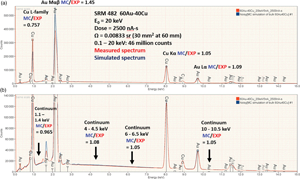Article contents
Energy-Dispersive X-Ray Spectrum Simulation with NIST DTSA-II: Comparing Simulated and Measured Electron-Excited Spectra
Published online by Cambridge University Press: 02 September 2022
Abstract

Electron-excited X-ray microanalysis with energy-dispersive spectrometry (EDS) proceeds through the application of the software that extracts characteristic X-ray intensities and performs corrections for the physics of electron and X-ray interactions with matter to achieve quantitative elemental analysis. NIST DTSA-II is an open-access, fully documented, and freely available comprehensive software platform for EDS quantification, measurement optimization, and spectrum simulation. Spectrum simulation with DTSA-II enables the prediction of the EDS spectrum from any target composition for a specified electron dose and for the solid angle and window parameters of the EDS spectrometer. Comparing the absolute intensities for measured and simulated spectra reveals correspondence within ±25% relative to K-shell and L-shell characteristic X-ray peaks in the range of 1–11 keV. The predicted M-shell intensity exceeds the measured value by a factor of 1.4–2.2 in the range 1–3 keV. The X-ray continuum (bremsstrahlung) generally agrees within ±10% over the range of 1–10 keV. Simulated EDS spectra are useful for developing an analytical strategy for challenging problems such as estimating trace detection levels.
Keywords
- Type
- Software and Instrumentation
- Information
- Copyright
- Copyright © The Author(s), 2022. Published by Cambridge University Press on behalf of the Microscopy Society of America
References
- 2
- Cited by



